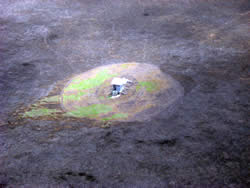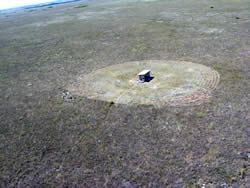Forests and Rangelands Success Story
Mechanical Fuel Reduction Protects Backcountry Structure
Everglades National Park, Florida
National Fire Plan - Fuels Reduction
2008

Aerial view of West Camp after the fuel break slowed and stopped the fire around the structure. NPS Photo by Robert Trincado.

Mowed fuel break around East Camp, 2008. NPS Photo by Sergio Martinez.
Researchers studying the federally listed endangered Cape Sable Seaside Sparrows (CSSS) spend up to a week at a time in the backcountry of Everglades National Park. Due to the extreme conditions in the backcountry, including severe thunderstorms and standing water at times, two shelters on platforms have been erected for those field observers to spend their nights. Simply named East Camp and West Camp, these shelters are accessible only by helicopter and located in the middle of the grasses. Firefighters flew into these camps in early April to put a firebreak in the grasses surrounding the shelters.
The West Camp Fire was ignited by lightning on the evening of June 22, 2008. Severe weather prevented the firefighting crew from getting to the fire until the next morning, as access was also only by helicopter. This wind-driven fire, burning mainly in dry marsh grasses interspersed with some hardwood hammocks grew to 2,500 acres by the time the crew arrived on the second day. The fire threatened the shelter that was its namesake and burned completely around it the first night. West Camp was left undamaged because the fuel break significantly decreased the fire intensity. No one was occupying the shelter at the time of the fire.
Contact: Rick Anderson, Fire Management Officer, (305) 242-7853.